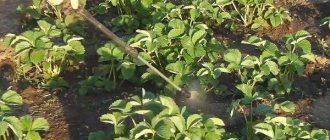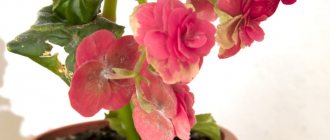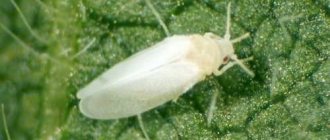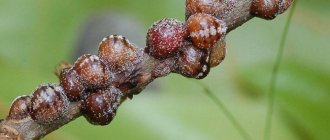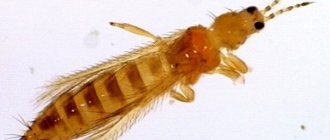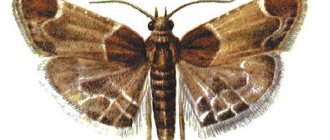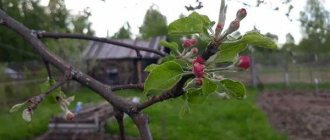Names of the main types of pests with photos
Pests that gardeners may find on their plants include:
- flower aphids;
- scale insect;
- spider mite;
- thrips;
- aphid;
- mealybug;
- white fools and others.
Flower aphid
Aphids pose a danger to outdoor and indoor plants. This insect enters the house in different ways: it flies from the street, moves from animal fur or from clothing. Aphids can “lurk” in a bouquet of flowers or soil that was purchased for replanting flora.
The flower parasite is difficult to notice with the naked eye. It is important to periodically inspect the plants to avoid missing the spread of aphids.
Five main signs will help you recognize the pest:
- the plant loses its fresh appearance and takes on a sickly appearance;
- the above-ground part of the bush is dotted with small punctures. The punctures act as tunnels through which aphids move around the flower;
- stems and foliage are unpleasant to the touch due to stickiness. The reason for this is the slimy substance secreted by pests. At advanced stages, the leaves turn black and fall off;
- open buds weaken and dry out. They are rapidly declining due to lack of nutrients;
- The plant is surrounded by ants. Aphids are a favorite delicacy of ants and they quickly find them in the apartment.
Reference. In those places where aphids settle, sooty fungus forms over time.
Scale insects (small light insects)
Scale insects are a frequent visitor to homes where citrus fruits, palm trees and oleanders grow. Despite its preferences, the insect is an omnivore and can be interested in any plants. Scale insects suck the juice from plants, which leads to the drying out and death of the plants.
There are four types of these insects:
- brown - affects ficus, laurels, palm trees and dracaenas;
- cactaceae - settle on cacti;
- olive - prefer oleanders, laurels, camellias, pomegranates, citruses and hibiscus;
- palmaceae - found on palm trees.
Due to their large size, female scale insects become visible even with a superficial inspection of the plants. Flowers on which these insects settle show the following symptoms:
- leaves become covered with brown-red spots. The presence of such spots indicates the location of scale insects;
- the leaves turn yellow and thin out;
- stems grow in the wrong direction;
- the plant loses buds and foliage.
Important! In the first stages of the “disease,” the plant can be helped. But when it loses all its foliage, no fertilizer or fungicide will save it.
Thrips (small black bugs)
Thrips pose a particular danger to plants. In addition to sucking juice, they carry dangerous diseases. These insects are polyphagous (or omnivorous) and can harm all types of plants. Undeveloped wings prevent thrips from flying. They move on the ground (with the exception of the bread subspecies).
There are four types of pests found indoors:
- heterovorous - live in ornamental and fruit plants. Flowers and developing ovaries are damaged;
- western floral - spread over fruit, berry and flower plants. In Russia it is found in greenhouses;
- tobacco - vegetable and flower crops grow;
- rosaceae - destroy rosaceous plants.
Due to their microscopic size and inconspicuous coloring, these insects are almost invisible. The following manifestations can indicate a flower is infested with pests:
- multiple punctures appear on the leaves;
- the leaves become discolored and become withered;
- leaves and flowers become covered with brown spots;
- the trunk and buds are deformed;
- the foliage dies and falls - if the plant is not helped in time.
Reference. Before treating a plant for thrips, it should be washed in the shower.
Mealybugs
Mealybugs are large (up to 1 centimeter) and quickly catch the eye of the gardener. They are distinguished from other insects by their light color.
A cluster of scale insects gives the impression of a white cobweb that engulfs the plant. Of all the indoor flowers, these pests choose orchids and violets. They are also attracted to exotic cacti.
During their life, mealybugs secrete honeydew. This substance serves as a favorable environment for the appearance of fungal diseases. Therefore, scale insects never come alone - they are always followed by sooty fungus. Insects harm both the root system and the above-ground parts of the plant.
Mealybugs can be recognized by simple signs:
- a waxy coating that looks like pieces of cotton wool or cobwebs;
- sticky leaves (due to honeydew or honeydew);
- wilting of the plant.
Reference. Simply wiping the leaves will help prevent mealybugs.
White fools and others
Podurs share a pot with all indoor plants. They live and reproduce in the soil. A moderate amount of these inhabitants does not threaten the well-being of flowers. If the fools begin to actively reproduce, then the grower will have problems. The main factor that causes an increase in the number of insects is watering. Excess humidity is a favorable environment for pests.
For this reason, fools “love” plants that constantly require an influx of moisture. Since it is impossible to reduce watering of such varieties, you should look for another solution. Flower growers use insecticides or folk remedies, depending on the approach.
Podurs are not capable of destroying a plant alone. They can weaken his immunity. As a result of this damage, the flower will become susceptible to rot and infectious diseases. The negative effect will increase if the plant is in a room with low temperature.
Reference. Violets and orchids tolerate the invasion of white fools the worst.
Why do these pests appear on flowerpots?
Midges may appear in flowers and on the surface of the soil of flowerpots in the following cases:
How to get rid of midges in flowers
- poor quality soil for planting flowers. It may contain particles of plants that have not completely rotted, which will later become a breeding ground for insects;
- use for watering tea or other liquids other than water;
- replanting flowerpots into too large a pot. In this case, in the lower part the soil is too moist, since the roots of the plant cannot absorb water at this level;
- intensive watering of the soil. Stagnation of water in the soil provokes putrefactive processes that attract insects;
- use of organic endorsements.
You also need to take into account that insects do not appear on all house plants. These pests love indoor flowers that have soft leaves. These include begonia, fuchsia and others. And some varieties, on the contrary, prefer flowerpots with fleshy leaves - violet, ficus, azalea.
Midges on indoor flowers
How to identify parasites?
A florist can diagnose a flower disease only by external signs. The leaves give basic information about the condition of the plant. They may change color, dry out or fall off. Another alarming symptom will be the appearance of a rotten smell.
We will talk about what signs you should pay attention to when examining home flora in this section.
The appearance of a white coating
A white coating indicates that the plant has been attacked by insects or microorganisms. If a gardener discovers whitish marks on the leaves, it is necessary to quickly take measures to save the flower.
The culprits for the appearance of plaque may be:
- powdery mildew - rapidly spreads throughout the flower and covers it with mycelium. Dew selects those plants that are over-watered. Fluctuations in room temperature can also be a pretext for the appearance of spores. The disease is contagious and dangerous to nearby plants. During treatment, the infected flower must be isolated;
- Mealybugs - insects settle on the underside of the leaf and suck moisture from the plant. Due to the fact that the leaves get stuck in the honeydew, the plant begins to wither and soon dies;
- mold - the appearance of mold spots confirms that the flower is damaged by fungal mycelium. Mold is not considered a disease, but can deplete flora. It appears from excessive watering of the plant. In order to cope with this fluffy coating, it is necessary to reconsider the spraying scheme;
- gray rot - at the initial stages, rot is localized on the stems and leaf petioles. Over time, it takes over the entire plant. It will not be possible to cure a flower from gray rot, since all medicines are powerless. The only way to combat the disease is to destroy infected specimens.
Reference. The appearance of all ailments that cause white plaque can be prevented with proper care. If the grower begins to monitor temperature conditions and watering, his plants will remain healthy.
What do yellow spots signal?
Yellow spots are a general symptom that does not relate to a specific disease. Yellowing of leaves is caused by both fungal diseases and errors in care.
Among the prerequisites for the formation of yellow spots are:
- temperature violation. If the temperature is incorrect, the leaves turn yellow, red or white. The color change is accompanied by the formation of a crust due to sunburn. To save the flower, you need to move it to the shadow side. It is advisable to remove damaged leaves;
- inconsistent watering. Yellow-brown spots are a sign of a thirsty plant. Lack of moisture causes the edges of the leaves to dry out. The spots then spread throughout the flower. If the affected areas are soft, then there is excess moisture;
- incorrect feeding scheme. Plants that are overfed with inappropriate fertilizers suffer from chlorosis. The disease prevents the leaves from producing chlorophyll, which affects their appearance. Chlorosis is easy to recognize - green areas remain only in places where veins are present;
- unsuitable conditions. Tender plants do not respond well to water if it gets on their leaves. This one event can cause yellowing. Another common cause is old potting soil.
Deformation of flower leaves
Deformation or “curl” of leaves is characterized by the growth of individual sections of the leaf and the formation of swellings. The swellings become green, yellow, pink or white.
The presence of such changes may indicate:
- vital activity of ticks;
- viral activity;
- development of fungal infection;
- exposure to chemicals;
- burn.
Deformation of the leaves is not dangerous to the life of the flower. An unfavorable prognosis awaits the plant if it suffers from a virus or a chemical burn.
Chemical burns occur due to improper application of fertilizers. They are characteristic of garden plants, but are also found in indoor plants. Dealing with a burn is not easy because it affects both the plant and the soil. It is impossible to transplant weakened flora into new soil without consequences.
Reference. If the deformation is at the initial stage, then it needs to be combated by improving the soil. The grower must loosen the soil and add new soil. It is advisable to use drugs that stimulate plant growth.
Preventative measures to prevent small bugs from appearing
Prevention measures are not particularly difficult:
- flowers need to be periodically inspected from the underside of the leaves;
- new crops purchased in a store should be kept in quarantine for several days;
- avoid waterlogging the soil;
- use drainage;
- do not allow the air in the room to become excessively dry;
- Spray regularly.
The measures taken will be quite enough to protect the flower from pest invasion. And if it does happen, there is no need to panic. Try to determine who exactly you are dealing with. And start fighting - the sooner the better.
How to deal with them at home?
Pest control methods depend on the type of disease. Radical methods involve treating greenery with chemicals. Biological agents have a gentler effect on flowers, but quickly dissolve in the soil. At the initial stages of the disease, traditional methods are also effective.
Mechanical methods of control
Mechanical methods involve physical extermination of pests. In addition to destruction, flower growers block insects' access to plants.
In practice, this method consists of simple steps:
- collecting insects by hand (if their size allows). Scale insects, scale insects and caterpillars “come unstuck” from the leaves. It is important to clean the plants carefully so as not to damage them;
- wiping with a cotton pad. Soaked cotton wool helps get rid of aphid accumulation;
- contrast shower and water spraying. If insects are concentrated on the green part of the plant, then targeted watering will get rid of them.
Important! Mechanical methods help remove only part of the pests from the plant. No gardener can clean a flower completely by hand. This method is the initial stage in a long struggle.
How to spray with chemicals?
There are no universal instructions for treating plants with chemicals. Each drug has its own characteristics and corresponding instructions.
There are two methods of moisture distribution:
- water mist. Fine spray nozzles are used to create fog. After spraying, the water does not flow into the soil and falls evenly on the leaves. The method is used for those chemicals that should not get into the ground;
- splashing. Used for spot processing. The method involves a large consumption of water, which saturates the soil. It is effective in situations where small areas of the plant are treated.
Important! When working with chemicals, consider their expiration dates and do not exceed the dosage. Too much medication can cause more damage than the disease.
Biological
Biological methods involve the use of fungicides based on beneficial bacteria. These drugs lead to the death of pathogenic microorganisms and do not damage the plant.
The advantage of biological fungicides is their low level of toxicity. But compared to chemicals, they show less effectiveness.
Fungicides are used in three directions:
- dressing seeds before planting;
- spraying the above-ground part of the plant;
- soil impregnation.
Based on their intended purpose, biological drugs are divided into preventive and therapeutic.
Preventive ones help the plant maintain immunity and act as a protective layer. Therapeutic treatments are used when the disease has been identified.
The composition of fungicides classifies drugs into one of the groups:
- organic - decompose in the soil with the help of microorganisms;
- inorganic - contain metals that are stored in the soil.
At home, gardeners treat plants with the following fungicides:
- gamair P;
- Alirin-B;
- phytosporin;
- agate;
- baktofit;
- trichodermin.
Important! Treatment of plants with biological preparations is carried out early in the morning.
Folk ways to treat the land against diseases
Traditional methods of combating diseases of indoor plants suggest trying the following components:
- citrus. Citrus peels repel fools. Oranges, tangerines, grapefruits and limes are used. The peel is pre-crushed and then distributed over the surface of the soil;
- garlic. To prepare the infusion, take one crushed head of garlic and pour in a liter of boiling water. The liquid is infused for one week and then diluted with water. For a liter of clean water, 5 milliliters of infusion is enough. The solution is poured into a spray bottle, with which you need to spray the plant evenly;
- potassium permanganate. A solution of potassium permanganate is effective and dangerous at the same time. Excess potassium permanganate will cause burns to the roots of the flower. To avoid this, it is necessary to dilute potassium permanganate in stages. The liquid is used to spray leaves and soak the soil. It is effective against aphids, mites and whiteflies.
Important! Traditional methods help in the initial stages of damage. Advanced stages require the use of drugs.
Measures to prevent the appearance of insects on indoor plants
Preventing diseases is the surest way to combat them. There are a few simple rules that will help reduce the risk of pests to zero. Disinfected soil is considered the key to a healthy flower.
Soil treatment against larvae
Soil disinfectants can be purchased at every flower shop. It is important to understand that they are toxic. Products should be used carefully and only after reading the instructions.
Popular drugs include:
- copper sulfate. The product cleanses the soil and enriches it with copper, which strengthens the plant. One spoon of vitriol dissolves in 10 liters of liquid. The soil is saturated with the solution twice a year - in autumn and spring;
- phytosporin. The drug was created based on the bacterium Bscillus Subtilis. This bacterium destroys microbes and nematode larvae. The soil should be treated with phytosporin every 3-4 months, since the bacterium is short-lived;
- Actara. The product is used before planting seeds or transplanting adult plants. Before digging, the soil must be loosened and moistened. Then the dry preparation is mixed with the soil.
Important! After disinfecting the soil, it is important to stabilize its acidity level. This can be done using dolomite flour, ash or chalk.
Visual inspection of flower leaves
The florist learns about a plant disease by external signs. The visual criterion requires increased attention. The previous sections listed the signs of major diseases and now it is time to summarize them.
The following manifestations should be a cause for concern:
- change in leaf color (white, rusty, yellow or gray spots);
- the appearance of a sticky layer on the leaves;
- leaf falling for no apparent reason;
- leaf deformation;
- drying of greenery (both at the edges and in the center);
- unpleasant odor from the plant.
Reference. Flower diseases are divided into superficial and vascular. Vascular diseases spread throughout the plant and accelerate its wilting. Superficial ones damage the leaves and are accompanied by growths, rot or spots. Mixed diseases also occur.
It is advisable to inspect the plants weekly. Pathogenic microorganisms are able to quickly move to neighboring flowers. If a gardener is late with diagnosis, he risks losing his home garden.
5 / 5 ( 1 voice )
